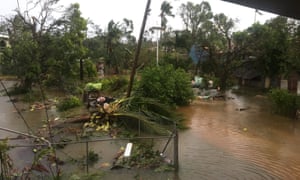Winds of more than 230km/h recorded as parliament building flattened and power lines brought down
Gita hit Tonga around 8pm on Monday night and peaked between 11pm and 2am, slamming on to the south coast of the main island of Tongatapu, bringing down electricity lines, smashing churches and levelling fruit trees and crops vital to the island’s livelihood.
At its peak, winds reached 233km/h – far stronger than predicted, despite Gita not reaching a category five storm as anticipated.
According to the British Met office, Gita is the worst cyclone to pass so close to Tonga’s main islands in 60 years, and communications were lost overnight as Gita ripped the roof off the Tonga meteorological office as well as taking the national broadcaster off air for a time.
Graham Kenna from Tonga’s National Emergency Management Office told Radio New Zealand the damage was widespread and severe, and could be the worst in the outer islands where information was slow to obtain.
“A lot of the landmark buildings are extremely badly damaged or even destroyed, the landmark tree ... near the palace, has been been destroyed ... it’s quite a bad situation.”
New Zealand has released NZ$750,000 in emergency relief funding, and prime minister Jacinda Ardern said the defence force was on standby to deploy as soon as Tongan authorities specified what assistance they required from her government.
Newshub Pacific correspondent Michael Morrah, who is in the capital Nuku’alofa, reported dozens of houses had been destroyed by the storm. He captured widespread flooding and wreckage across the capital and reported the levelling of a number of significant landmarks, most notably Parliament House.
Tonga’s emergency response team said they were struggling to assess damage around the capital and the islands due to debris blocking roads and downed power lines, and were not likely to have a comprehensive assessment of the disaster until Wednesday.
Mary Fonua, the managing editor of the online news website Matangi Tonga, remained awake in her family home overnight, pacing the house and watching the windows blow out and the solar panels ripped from the roof.
“The wind was terrifying, it was tearing overhead and we could hear roofs being lifted. Amazingly, emergency services were still going out,” Fonua told Radio New Zealand.
Sione Taumoefolau, the secretary general of the Red Cross in Tonga, said he had dispatched his teams at first light to begin assessing the damage and clearing ruined streets. He said by initial estimates the damage in the capital was severe.
“At this stage we have no reports of causalities and only minor injuries, so I think we can be grateful for that. But we do not have good information on the outer islands, so we will have to wait and see what we find today. It was a frightening night, the entire house was shaking.”
The Kingdom of Tonga is made up on 176 islands, though only 40 are inhabited.
Gita was picking up pace as it banked south for Fiji, and was expected to hit the Lau Islands south of the mainland around midday on Tuesday.
New Zealand’s foreign affairs minister, Winston Peters, said emergency supplies had been prepared on Monday and were ready to be dispatched to the islands at the first call from the Tongan government.
“Initial assessments of the damage are still coming in. However, it is clear that Cyclone Gita has caused significant damage,” Peters said.
“This is an initial contribution that will enable us to respond quickly to requests from the government of Tonga to meet immediate needs, such as emergency shelter, water and sanitation. We stand ready to provide additional support as the extent of the damage becomes clear.”
Unicef New Zealand also said it was prepared to respond to the disaster and had already dispatched some emergency supplies to Fiji.

No comments:
Post a Comment